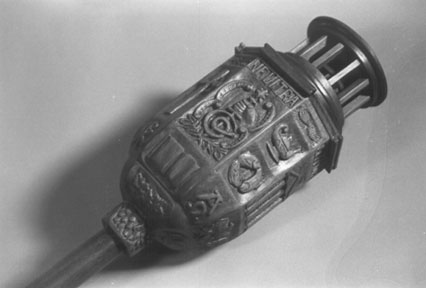|
The side of the mace with “Ne Ultra” carved in it. [1987]
25-0044.01 |
Also known as: the Sesquicentennial Mace.
The Davidson College mace made its début on January 29, 1988 in time for the college’s Sesquicentennial Celebration. Planning for this mace had begun eight years earlier under President Samuel Spencer, Jr., and the idea was commissioned by the Board of Trustees.
The elaborate design of the mace was assisted by research and suggestions from Chalmers G. Davidson (college archivist), Leland M. Park (director of the library), Rupert T. Barber, Jr. (Coordinator of the Sesquicentennial Celebration), and President Kuykendall.
The final design, choice of wood (Honduran mahogany), and carving was done by Jack H. Ramseur ’31 of Lincolnton, NC, in honor of his class. Jack Ramseur was a retired textile executive who had learned woodworking skill from his uncle circa 1950 made much of his own furniture by hand.
 |
|
Jack H. Ramseur ’31 carving the Mace. [November 1987]
14-0003 |
The mace he created for the college is truly a work of art:
“The carving on the top of the mace represents the cupola of ‘Old Chambers’ the impressive building which was the center of the college’s academic life until its destruction by fire in 1921. Immediately below the cupola is the eight-sided base of the dome of the present Chambers Building, again the academic center of campus since being rebuilt in 1931. Forming a circular band just below this base are the words Ne Ultra from the college seal and the words of the college motto, Alenda Lux Ubi Orta Libertas.
Below this band the knop consists of four wide and four narrow panels. On each of the wide panels is a major design representative of the college. The college seal, design by Peter Stuart, is one of theses and the Sesquicentennial logo, designed by James Burkey Belser ’69, is another. The two remaining wide panels are devoted largely to carvings which show the historic literary society halls, built in the 1840s…
Accompanying the college symbols are a number of smaller designs which reflect Davidson’s historic ties with the church. Among these are three Christian symbols with traditional Presbyterian associations: the star of Epiphany, the Holy Spirit descending in the form of a dove and the burning bush. All three were symbols used on the seal of the Presbyterian Church in the U.S.; the dove and the burning are a part of the seal of the Presbyterian Church (USA), adopted in 1985.
 |
|
Grand Marshal Dr. Leland Park holds the college mace.
[18 May 1997] 11-0445 |
Clusters of leaves adorn the base of the knop as it tapers toward the rod. Oak and elm leaves recall two of the college’s original buildings, Oak and Elm Rows, built as dormitories in 1836-7. Maple and dogwood leaves suggest the natural beauty of the Davidson campus and, in the case of the dogwood, form a link with the state of North Carolina from which Davidson College received its charter in 1838 and whose state flower is the dogwood. Grape clusters and leaves, symbolic of life and of Chirst as the true vine, entwine the base of the knop just above the rod and ornament the bands which divide the rod into three sections as it descents to the fluted orb.”
– Mary Beaty
The mace is now carried annually by the Chief Marshal at Davidson College Commencement.
Davidson College Mace – Works Cited
“The Davidson College Mace.” Celebrating 150 Davidson Years. Article, January 29, 1988. Mace of Davidson College. Davidsoniana file. Davidson College Archives, Davidson, NC.
“Alma Mater’s Mace-Maker.” Davidson Update. Article, January 1988. Mace of Davidson College. Davidsoniana file. Davidson College Archives, Davidson, NC.
“Appendix VIII: The Davidson College Mace From and Essay by Dr. Mary Beaty.” Mace of Davidson College. Davidsoniana file. Davidson College Archives, Davidson, NC.
Author: Tammy Ivins
Date: August 2007
Cite as: Ivins, Tammy. “Davidson College Mace” Davidson Encyclopedia August 2007 <https://davidsonarchivesandspecialcollections.org/archives/encyclopedia/mace/>
Related entries: Chambers Building, Oak and Elm Rows, Peter Stuart Ney, Eumenean and Philanthropic Literary Societies, Arboretum


Sorry, comments are closed for this post.